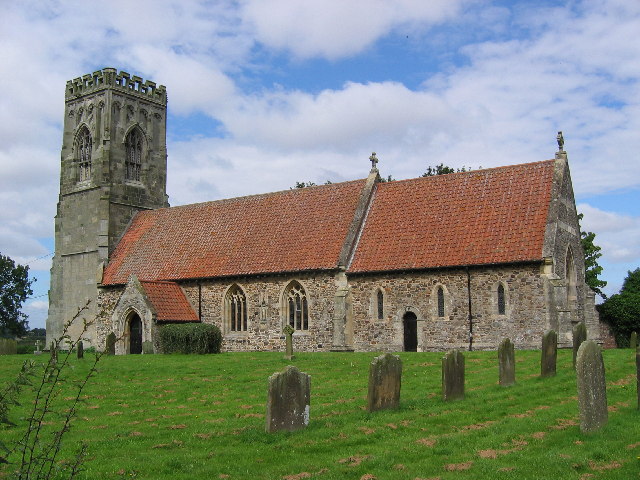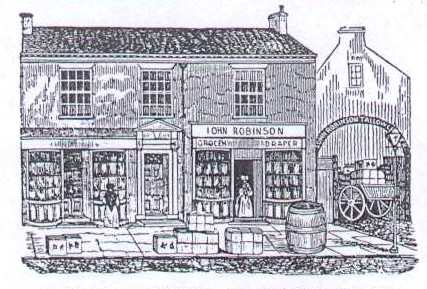|
Fridaythorpe
Fridaythorpe is a village and civil parish in the East Riding of Yorkshire, England. It is situated approximately north-east of Pocklington town centre and lies on the A166 road. It is above sea level, making it the highest village in the Yorkshire Wolds. According to the 2011 UK census, Fridaythorpe parish had a population of 319, an increase on the 2001 UK census figure of 183. St Mary's Church, Fridaythorpe was restored in 1902–3 with the addition of a new north aisle designed by C. Hodgson Fowler and stained glass by Burlison and Grylls. In January 1967 the church was designated a Grade I listed building and is now recorded in the National Heritage List for England, maintained by Historic England. It is on the Sykes Churches Trail devised by the East Yorkshire Churches Group. The Yorkshire Wolds Way National Trail, a long distance footpath passes through the village and the village is the midpoint of the trail. Village amenities include a Mace general shop and p ... [...More Info...] [...Related Items...] OR: [Wikipedia] [Google] [Baidu] |
Sykes Churches Trail
The Sykes Churches Trail is a tour of East Yorkshire churches which were built, rebuilt or restored by the Sykes family of Sledmere House in the East Riding of Yorkshire, England. The tour was devised by the East Yorkshire Historic Churches Group and is divided into a southern circuit and a planned northern circuit. Work on the churches was financed by Sir Tatton Sykes, 4th Baronet (1772–1863) and his son Sir Tatton Sykes, 5th Baronet (1826–1913). The 4th Baronet engaged John Loughborough Pearson to work on churches at Garton on the Wolds, Kirkburn, Bishop Wilton and Hilston in Holderness. The 5th Baronet worked with the architects C. Hodgson Fowler, G.E.Street and Temple Moore Temple Lushington Moore (7 June 1856 – 30 June 1920) was an English architect who practised in London. He is famed for a series of fine Gothic Revival churches built between about 1890 and 1917 and also restored many churches and designed ch .... His achievements were far greater than his fa ... [...More Info...] [...Related Items...] OR: [Wikipedia] [Google] [Baidu] |
A166 Road
The A166 road is a trunk road between the outskirts of York and Driffield in the historic county of Yorkshire. The road used to terminate at the seaside town of Bridlington, until the opening of the Driffield by-pass caused the final section to be renumbered as the A614. History The A166 follows the path of an old Roman road from York to Stamford Bridge, where it forded the river at the place where the modern Stamford Bridge is located. The bridge is mentioned in the '' Anglo-Saxon Chronicle'' about the Battle of Stamford Bridge in 1066. The road was turnpiked between York and Stone Dale as part of the York, Kexby Bridge, Grimston and Stone Dale Turnpike Trust established in 1806. A turnpike Trust had existed since 1765, but this included new maintenance provisions. The Trust lasted until 1872. The turnpike started from Grimston Smithy and the introduction of a toll bar on the road at this place led to the eventual change of name to Grimston Bar. There are a number of sch ... [...More Info...] [...Related Items...] OR: [Wikipedia] [Google] [Baidu] |
Yorkshire Wolds Way
The Yorkshire Wolds Way is a National Trail in Yorkshire, England. It runs 79 miles (127 km) from Hessle to Filey, around the Yorkshire Wolds. At Filey Brigg, it connects with the Cleveland Way, another National Trail. In 2007 the Yorkshire Wolds Way celebrated the 25th anniversary of its official opening which took place on 2 October 1982. Route The route of the Yorkshire Wolds Way passes close to or through the following places: * Hessle * North Ferriby * Melton * Welton * Brantingham * South Cave * North Newbald * Goodmanham * Market Weighton * Londesborough * Nunburnholme * ''Pocklington'' * Millington * Huggate * Fridaythorpe * Thixendale * Wharram Percy * Wharram le Street * Wintringham * Sherburn * Potter Brompton * Ganton * Muston * Filey Places in italics are slightly off the main route. BBC documentary ''Yorkshire Wolds Way'', a 2017 two-part BBC television documentary, features a journey along the Yorkshire Wolds Way. Presenter Paul Rose describe ... [...More Info...] [...Related Items...] OR: [Wikipedia] [Google] [Baidu] |
Mace (store)
Mace is a convenience shop symbol group operating as three separate entities with different ownerships in Great Britain, the Republic of Ireland and Northern Ireland. The shops are independently owned and join the groups, paying a fee for marketing and branding support and purchasing their stock from the brand owners. United Kingdom Great Britain The Mace brand has had several owners in its history in Great Britain, and is currently owned there by Costcutter Supermarkets Group. Palmer and Harvey acquired the entire rights to Mace throughout Great Britain in 2005, finally unifying the brand under one owner. This stability has allowed the brand to recover from defections by retailers caused by frequent disruptive changes of ownership of the brand in the past. Despite this, from the early 2000s onwards, the brand gained a reputation for being overpriced. This later lead to the colloquial phrase “mace up price” being coined to refer to something overly expensive. In ... [...More Info...] [...Related Items...] OR: [Wikipedia] [Google] [Baidu] |
Flat Cap
A flat cap is a rounded cap with a small stiff brim in front, originating in Britain and Ireland. The hat is known in Ireland as a paddy cap; in Scotland as a bunnet; in Wales as a Dai cap; and in the United States as an English cap, Irish cap, or flat cap. Various other terms exist (cabbie cap, driver cap, longshoreman cap, ivy cap, train engineer cap,etc.). Cloths used to make the cap include wool, tweed (most common), and cotton. Less common materials may include leather, linen, or corduroy. The inside of the cap is commonly lined for comfort and warmth. History The style can be traced back to the 14th century in Northern England, when it was more likely to be called a "bonnet". This term was replaced by "cap" before about 1700, except in Scotland, where it continues to be referred to as a ''bunnet'' in Scots. A 1571 Act of the English Parliament was enacted to stimulate domestic wool consumption and general trade. It decreed that on Sundays and holidays, all males over ... [...More Info...] [...Related Items...] OR: [Wikipedia] [Google] [Baidu] |
Wesleyan Methodist Church (Great Britain)
The Wesleyan Methodist Church (also named the Wesleyan Methodist Connexion) was the majority Methodist movement in England following its split from the Church of England after the death of John Wesley and the appearance of parallel Methodist movements. The word ''Wesleyan'' in the title differentiated it from the Welsh Calvinistic Methodists (who were a majority of the Methodists in Wales) and from the Primitive Methodist movement, which separated from the Wesleyans in 1807. The Wesleyan Methodist Church followed the Wesleys in holding to an Arminian theology, in contrast to the Calvinism held by George Whitefield George Whitefield (; 30 September 1770), also known as George Whitfield, was an Anglican cleric and evangelist who was one of the founders of Methodism and the evangelical movement. Born in Gloucester, he matriculated at Pembroke College at th ..., by Selina Hastings (founder of the Countess of Huntingdon's Connexion), and by Howell Harris and Daniel Rowland (pre ... [...More Info...] [...Related Items...] OR: [Wikipedia] [Google] [Baidu] |
York
York is a cathedral city with Roman origins, sited at the confluence of the rivers Ouse and Foss in North Yorkshire, England. It is the historic county town of Yorkshire. The city has many historic buildings and other structures, such as a minster, castle, and city walls. It is the largest settlement and the administrative centre of the wider City of York district. The city was founded under the name of Eboracum in 71 AD. It then became the capital of the Roman province of Britannia Inferior, and later of the kingdoms of Deira, Northumbria, and Scandinavian York. In the Middle Ages, it became the northern England ecclesiastical province's centre, and grew as a wool-trading centre. In the 19th century, it became a major railway network hub and confectionery manufacturing centre. During the Second World War, part of the Baedeker Blitz bombed the city; it was less affected by the war than other northern cities, with several historic buildings being gutted and restore ... [...More Info...] [...Related Items...] OR: [Wikipedia] [Google] [Baidu] |
Driffield
Driffield, also known as Great Driffield, is a market town and civil parish in the East Riding of Yorkshire, England. The civil parish is formed by the town of Driffield and the village of Little Driffield. By road, it is north-east of Leeds, north-east of Sheffield, east of York, north of Hull and south-east of Middlesbrough. Driffield is named ''The Capital of the Wolds'', due to its location sitting centrally within the Yorkshire Wolds. According to the 2011 UK census, Driffield parish had a population of 13,080, an increase on the 2001 UK census figure of 11,477. The town was listed in the 2019 Sunday Times report on the Best Places to Live in northern England. History Driffield is of Anglo-Saxon origin, and the name is first attested in the ''Anglo-Saxon Chronicle'' where King Aldfrith of Northumbria died on the 14 December 705. It is also found in ''Domesday Book'' of 1086, meaning "dirty (manured) field". A Bronze Age mound outside Driffield was excavated in ... [...More Info...] [...Related Items...] OR: [Wikipedia] [Google] [Baidu] |
Public House
A pub (short for public house) is a kind of drinking establishment which is licensed to serve alcoholic drinks for consumption on the premises. The term ''public house'' first appeared in the United Kingdom in late 17th century, and was used to differentiate private houses from those which were, quite literally, open to the public as "alehouses", "taverns" and "inns". By Georgian times, the term had become common parlance, although taverns, as a distinct establishment, had largely ceased to exist by the beginning of the 19th century. Today, there is no strict definition, but CAMRA states a pub has four characteristics:GLA Economics, Closing time: London's public houses, 2017 # is open to the public without membership or residency # serves draught beer or cider without requiring food be consumed # has at least one indoor area not laid out for meals # allows drinks to be bought at a bar (i.e., not only table service) The history of pubs can be traced to Roman taverns in B ... [...More Info...] [...Related Items...] OR: [Wikipedia] [Google] [Baidu] |
Landlord
A landlord is the owner of a house, apartment, condominium, land, or real estate which is rented or leased to an individual or business, who is called a tenant (also a ''lessee'' or ''renter''). When a juristic person is in this position, the term landlord is used. Other terms include lessor and owner. The term landlady may be used for the female owners. The manager of a pub in the United Kingdom, strictly speaking a licensed victualler, is referred to as the landlord/landlady. In political economy it refers to the owner of natural resources alone (e.g., land, not buildings) from which an economic rent is the income received. History The concept of a landlord may be traced back to the feudal system of manoralism (seignorialism), where a landed estate is owned by a Lord of the Manor (mesne lords), usually members of the lower nobility which came to form the rank of knights in the high medieval period, holding their fief via subinfeudation, but in some cases the land may also ... [...More Info...] [...Related Items...] OR: [Wikipedia] [Google] [Baidu] |
Blacksmith
A blacksmith is a metalsmith who creates objects primarily from wrought iron or steel, but sometimes from #Other metals, other metals, by forging the metal, using tools to hammer, bend, and cut (cf. tinsmith). Blacksmiths produce objects such as gates, grilles, railings, light fixtures, furniture, sculpture, tools, agricultural implements, decorative and religious items, cooking utensils, and weapons. There was an historical distinction between the heavy work of the blacksmith and the more delicate operation of a whitesmith, who usually worked in Goldsmith, gold, Silversmith, silver, pewter, or the finishing steps of fine steel. The place where a blacksmith works is called variously a smithy, a forge or a blacksmith's shop. While there are many people who work with metal such as farriers, wheelwrights, and Armourer, armorers, in former times the blacksmith had a general knowledge of how to make and repair many things, from the most complex of weapons and armor to simple things ... [...More Info...] [...Related Items...] OR: [Wikipedia] [Google] [Baidu] |
Wheelwright
A wheelwright is a craftsman who builds or repairs wooden wheels. The word is the combination of "wheel" and the word "wright", (which comes from the Old English word "''wryhta''", meaning a worker or shaper of wood) as in shipwright and arkwright. This occupational name became the English surname ''Wright''. It also appears in surnames like ''Cartwright'' and ''Wainwright''. It corresponds with skilful metal workers being called ''Smith.'' These tradesmen made wheels for carts (cartwheels), wagons (wains), traps and coaches and the belt drives of steam powered machinery. They also made the wheels, and often the frames, for spinning wheels for home use. First constructing the hub (called the nave), the spokes and the rim segments called felloes, (pronounced fell low), and assembling them all into a unit working from the center of the wheel outwards. Most wheels were made from wood, but other materials have been used, such as bone and horn, for decorative or other purposes. ... [...More Info...] [...Related Items...] OR: [Wikipedia] [Google] [Baidu] |









